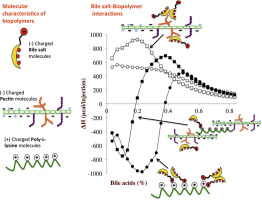当前位置:
X-MOL 学术
›
Food Hydrocoll.
›
论文详情
Our official English website, www.x-mol.net, welcomes your
feedback! (Note: you will need to create a separate account there.)
Interaction of a bile salt (sodium taurocholate) with cationic (ε-polylysine) and anionic (pectin) biopolymers under simulated gastrointestinal conditions
Food Hydrocolloids ( IF 11.0 ) Pub Date : 2019-02-01 , DOI: 10.1016/j.foodhyd.2018.08.029 Cynthia Lopez-Pena , Izlia J. Arroyo-Maya , David Julian McClements
Food Hydrocolloids ( IF 11.0 ) Pub Date : 2019-02-01 , DOI: 10.1016/j.foodhyd.2018.08.029 Cynthia Lopez-Pena , Izlia J. Arroyo-Maya , David Julian McClements

|
Abstract Dietary fibers are known to have beneficial effects on human health, which is partially attributed to their interactions with components in the gastrointestinal tract. In this study, the interaction of model bile salts with anionic (pectin) and cationic (polylysine) food-grade biopolymers, and their electrostatic complex, was examined. Isothermal titration calorimetry and titration measurements were used to characterize the nature of the interactions between the biopolymers and bile salts. Analysis of isothermal titration calorimetry data showed a marked difference for the taurocholate-pectin and taurocholate-e-polylysine complexes, suggesting that sodium taurocholate binds strongly to e-polylysine, presumably due to the attraction of oppositely electrical charges. While, the interaction between sodium taurocholate and pectin seems to be dominated by hydrophobic forces. On the other hand, the interaction of sodium taurocholate with a mixture of the two biopolymers showed a behavior that combined the characteristics of the individual systems. These results may have important implications for the design of functional foods to improve human health and wellness.
中文翻译:

在模拟胃肠条件下胆盐(牛磺胆酸钠)与阳离子(ε-聚赖氨酸)和阴离子(果胶)生物聚合物的相互作用
摘要 众所周知,膳食纤维对人体健康有益,部分原因在于它们与胃肠道中的成分相互作用。在这项研究中,研究了模型胆汁盐与阴离子(果胶)和阳离子(聚赖氨酸)食品级生物聚合物及其静电复合物的相互作用。等温滴定量热法和滴定测量用于表征生物聚合物和胆汁盐之间相互作用的性质。等温滴定量热数据分析显示牛磺胆酸盐-果胶和牛磺胆酸盐-e-聚赖氨酸复合物有显着差异,表明牛磺胆酸钠与e-聚赖氨酸结合强烈,可能是由于相反电荷的吸引力。尽管,牛磺胆酸钠和果胶之间的相互作用似乎受疏水力的支配。另一方面,牛磺胆酸钠与两种生物聚合物的混合物的相互作用表现出一种结合了各个系统特性的行为。这些结果可能对设计功能性食品以改善人类健康和福祉具有重要意义。
更新日期:2019-02-01
中文翻译:

在模拟胃肠条件下胆盐(牛磺胆酸钠)与阳离子(ε-聚赖氨酸)和阴离子(果胶)生物聚合物的相互作用
摘要 众所周知,膳食纤维对人体健康有益,部分原因在于它们与胃肠道中的成分相互作用。在这项研究中,研究了模型胆汁盐与阴离子(果胶)和阳离子(聚赖氨酸)食品级生物聚合物及其静电复合物的相互作用。等温滴定量热法和滴定测量用于表征生物聚合物和胆汁盐之间相互作用的性质。等温滴定量热数据分析显示牛磺胆酸盐-果胶和牛磺胆酸盐-e-聚赖氨酸复合物有显着差异,表明牛磺胆酸钠与e-聚赖氨酸结合强烈,可能是由于相反电荷的吸引力。尽管,牛磺胆酸钠和果胶之间的相互作用似乎受疏水力的支配。另一方面,牛磺胆酸钠与两种生物聚合物的混合物的相互作用表现出一种结合了各个系统特性的行为。这些结果可能对设计功能性食品以改善人类健康和福祉具有重要意义。









































 京公网安备 11010802027423号
京公网安备 11010802027423号